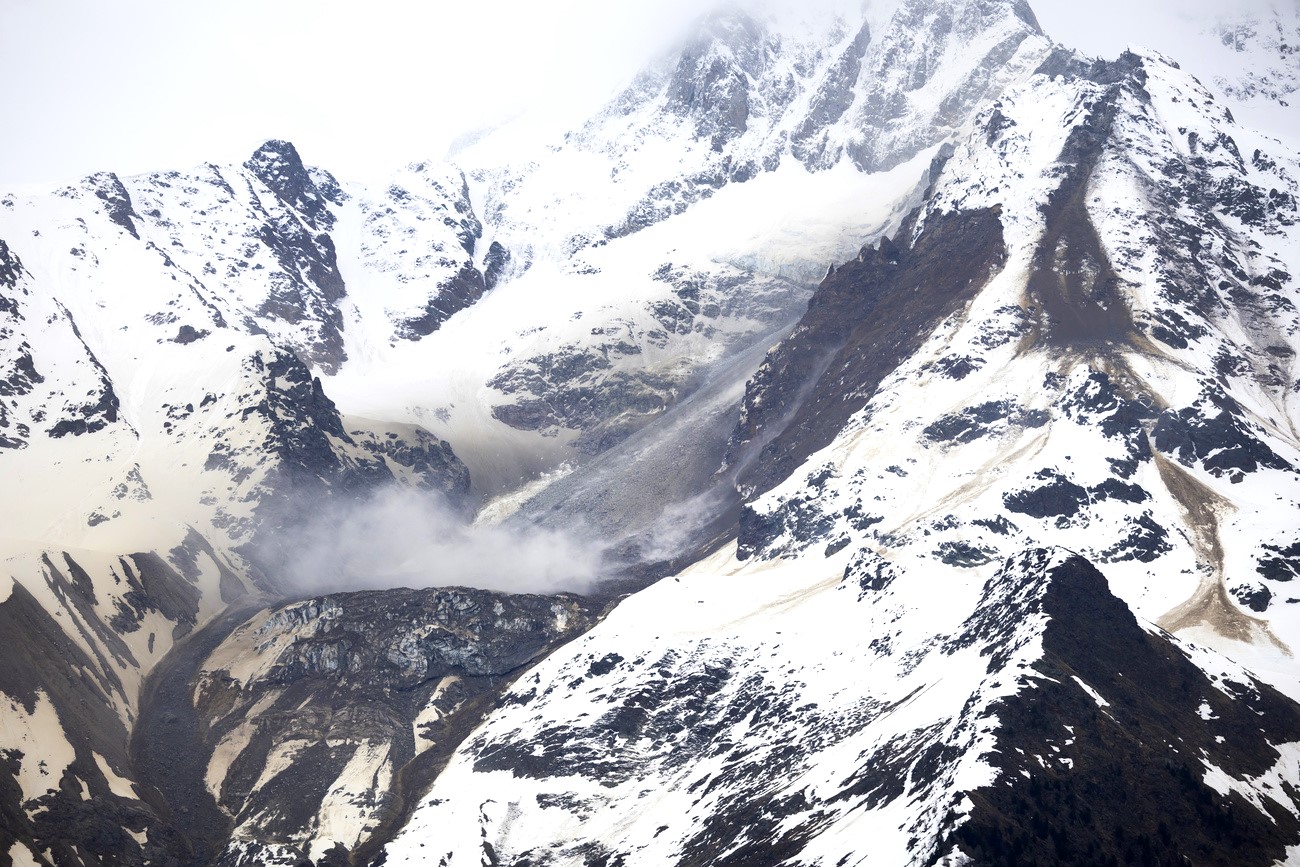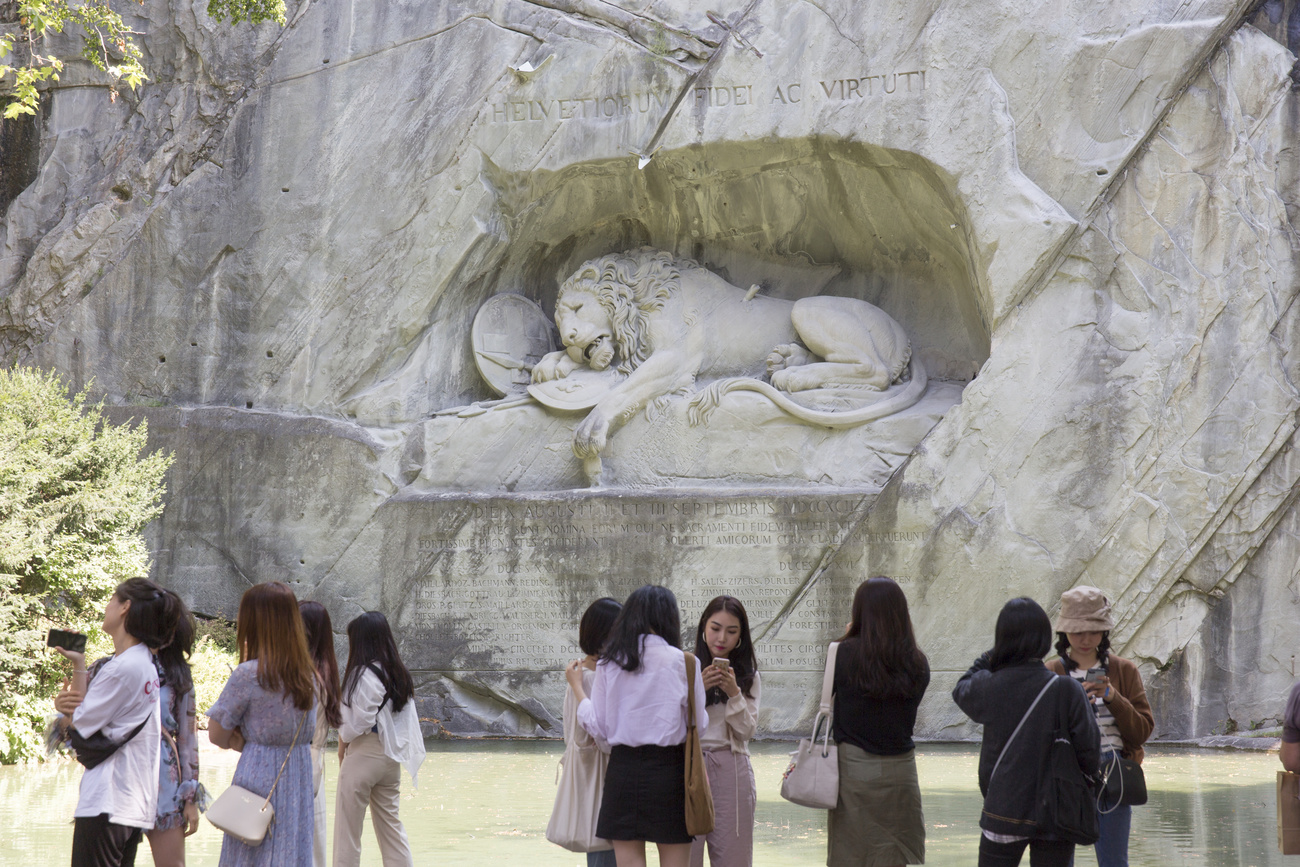
Climate change puts Swiss tourism to the test

Climate change is hitting Swiss tourism hard – and skiing in particular is feeling the heat. A tourism expert weighs in on the challenges facing the industry and whether climate-neutral tourism is more than just a pipe dream.
Climate change is transforming Switzerland – and the effect is being felt particularly in tourist regions.
“Rising temperatures are devastating for ski tourism,” says Monika Bandi, head of the research centre on tourism at the University of Bern. “There is also more frequent heavy rainfall in summer, less precipitation in winter, and thawing permafrost, which can make slopes unstable.”
One-third of the mountain huts operated by the Swiss Alpine Club are in dangerExternal link because they are in an area where the permafrost is thawing. Hiking trails are also under threat. “Natural hazards are increasingly expected in areas and during seasons that have so far been safe,” writes the Swiss Hiking Trail AssociationExternal link. Thawing permafrost, as well as heavy precipitation and wet snow avalanches at lower altitudes, will likely trigger more rockfalls.
>>On May 28 a glacier in southern Switzerland collapsed, burying the mountain village of Blatten.

More
Why do Swiss mountains collapse? It’s complicated
An extended autumn season
“The effects of climate change vary considerably depending on location and season,” says Bandi. “In the mountains, a lack of snow threatens ski tourism, while in summer, storms make it harder to enjoy outdoor activities.”
Still, not every impact is unwelcome. “In summer, the cooler Alpine climate may attract more visitors,” says the researcher. And at higher altitudes, autumn now often stretches into October or even November.
The organisation Switzerland Tourism has recently begun highlighting autumn activities in its ads, enlisting former tennis star Roger Federer and Danish actor Mads Mikkelsen in a promotional videoExternal link designed to entice more visitors to visit Switzerland between summer and winter.
Winter sports resorts have the biggest problem with rising temperatures. “Having 100 days with guaranteed 30-50 centimetres of snow is becoming increasingly unrealistic,” says Bandi. Scientists predict that the altitude at which zero degrees Celsius is reached (the 0°C isotherm) will rise by another 300 metres by 2050, according to a reportExternal link commissioned by the Swiss Cable Car Association.
Ski resorts at medium altitudes – up to 1,500 metresExternal link – are particularly vulnerable. In future, rain is likely to fall more often than snow at these elevations, especially at the start and end of winter, reducing the length of the ski season. Snow cannons offer little help, as they can only operate when temperatures stay below zero degrees Celsius.
>>Is a ski lift at 900 metres above sea level still worthwhile? A lift owner explains why he wants to continue operating it:
It remains difficult to predict just how far-reaching these changes will be for Switzerland as a winter sports destination. “Fewer children are learning to ski these days,” says Bandi. “In ten to 20 years, will people still be willing to spend CHF80 [$100] to CHF100 on a ski day?” she asks.
The Swiss Cable Car Association notes in its adaptation strategyExternal link that demand is expected to decline. Already, more than 60 abandoned ski lifts dot the Swiss landscape – and with temperatures continuing to rise, that number is bound to go up.
To offset losses from the winter season, traditional winter resorts such as Lenzerheide, Arosa and Saas Fee have broadened their offeringsExternal link to attract summer visitors seeking more than just hiking trails.
The mountain destinations are investing in summer infrastructure by building mountain bikingExternal link or running trails, installing climbing parks, and creating themed hiking routes. Many now also offer yoga retreats and leisurely hikes that combine scenic views with culinary or cultural experiences.
Switzerland Tourism told Swissinfo that it is promoting new attractions such as the Glacier Experience TrailExternal link in the Engadine region, the Arosa Bear SanctuaryExternal link, and efforts to expand summer tourism with a focus on biking, such as in Disentis SedrunExternal link.
Tourism is a CO2 producer
Tourism in Switzerland is not only affected by climate change, but it also contributes to it. Although CO2 emissions are easy to measure, they are hard to eliminate.
“Two-thirds of a trip’s carbon footprint comes from getting there and back, especially in the case of long-distance travel,” says Bandi.
One way to reduce this footprint would be to attract guests from nearby who stay longer at a destination. “Regular loyal guests, like those who go to Scuol or Adelboden,” Bandi explains, “tend to leave a smaller carbon footprint.”
Other destinations, such as Interlaken or Jungfraujoch, depend on a steady stream of new guests from all over the world. But for now, using sustainable aviation fuel is not possible, and carbon offsetting does not really mitigate the damage.
The remaining third of the carbon footprint stems from the food, buildings and infrastructure used in tourist activities. “Cable cars mostly run on hydroelectricity, so they are not a big factor,” says Bandi. Accommodation providers are working to reduce emissions and become more energy self-sufficient, by installing rooftop solar panels, for instance, and by shifting towards vegetarian or vegan menus.
>>Tourism is booming – but how can it become more sustainable? A WEF expert is betting on technology:

More
‘Balancing growth and sustainability is the challenge of the century for the tourism sector’
One rare success story, according to Bandi, is the network of Swiss youth hostels. Despite growth over the past 20 years, they have managed to halve their CO2 emissions by using environmentally friendly construction methods and offering less meat on their menu. It also helps that they cater to guests who come from nearby and who have not flown into the country.
Regional projects for more sustainability
Entire tourism regions have also launched their own initiatives to reduce their emissions footprint, such as the Myclimate Climate Fund DavosExternal link. It relies on voluntary contributions from guests – then matched by local businesses – to finance climate-action projects such as renovating buildings and installing solar panels.
The goal is to reduce CO2 emissions in the region without needing new laws. The Arosa resort, for one, has launched the Arosa 2030External link strategy with the aim of becoming one of the most sustainable destinations in the Alps. It hopes to bring growth and sustainability under one roof.
This, Bandi says, is precisely where the difficulty lies: “You can come up with smart ways to shrink your environmental footprint. But if you are growing the business at the same time, those gains get cancelled out.”
At the federal level, the government’s 2050 net-zero target applies across all sectors, including tourism. According to Bandi, ski resorts will face the greatest challenges in meeting this goal.
“The lifts can be operated in a CO2-neutral way,” she explains. But the snow groomers have a huge energy footprint. For flatter cross-country ski trails, electric models could be used, but not on steep alpine runs. “At the end of the day,” she says, “tourism has a complicated relationship with sustainability.”
– The seasons are stretching and even starting to blur together. In November, Arosa and Lenzerheide now offer skiing, biking and hiking – all at onceExternal link.
– Ski resorts are reaching for new heights. As runs at lower altitudes become unskiable, winter sports destinations are looking upwards. In Zermatt, with plans for a new restaurant at 3,800 metres above sea level, artificial snow on the Theodul Glacier and the Klein Matterhorn, operators are hoping for snowy winters and cool summers.
– Joining forces, Andermatt, Sedrun and Disentis have united to create a connected ski area offering higher altitudes and more reliable snow. Andermatt is embracing year-round tourismExternal link with golf, a concert hall and upscale restaurants.
– In response to the lack of snow in recent years, the Sörenberg ski area reintroduced a fixed-price system for ski passes. A previous flexible-pricing model had proved unsuccessful because of uncertainty about snow conditions. In 2024, the resort opened a new restaurant on the mountaintop Brienzer Rothorn, branded as the “top of the biosphere.”
Edited by Balz Rigendinger/Adapted from German by David Kelso Kaufher/gw

More
Our science newsletter

In compliance with the JTI standards
More: SWI swissinfo.ch certified by the Journalism Trust Initiative































You can find an overview of ongoing debates with our journalists here . Please join us!
If you want to start a conversation about a topic raised in this article or want to report factual errors, email us at english@swissinfo.ch.